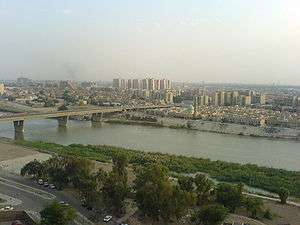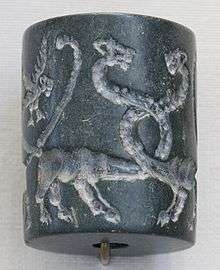Tigris
| Tigris | |
| River | |
| About 100 km from its source, the Tigris enables rich agriculture outside Diyarbakır, Turkey. | |
| Countries | Turkey, Syria, Iraq |
|---|---|
| Tributaries | |
| - left | Batman, Garzan, Botan, Khabur, Greater Zab, Lesser Zab, 'Adhaim, Cizre, Diyala |
| - right | Wadi Tharthar |
| Cities | Diyarbakır, Mosul, Baghdad |
| Source | Lake Hazar |
| - elevation | 1,150 m (3,773 ft) |
| - coordinates | 38°29′0″N 39°25′0″E / 38.48333°N 39.41667°E |
| Mouth | Shatt al-Arab |
| - location | Al-Qurnah, Basra Governorate, Iraq |
| Length | 1,850 km (1,150 mi) |
| Basin | 375,000 km2 (144,788 sq mi) |
| Discharge | for Baghdad |
| - average | 1,014 m3/s (35,809 cu ft/s) |
| - max | 2,779 m3/s (98,139 cu ft/s) |
| - min | 337 m3/s (11,901 cu ft/s) |
 | |
| [1] [2] | |

The Tigris (/ˈtaɪɡrɪs/) (Arabic: دجلة, Arabic pronunciation: [didʒlah]) is the eastern member of the two great rivers that define Mesopotamia, the other being the Euphrates. The river flows south from the mountains of southeastern Turkey through Iraq and empties itself into the Persian Gulf.
Geography
The Tigris is 1,750 km long, rising in the Taurus Mountains of eastern Turkey about 25 km southeast of the city of Elazig and about 30 km from the headwaters of the Euphrates. The river then flows for 400 km through Turkish territory before becoming the border between Syria and Turkey. This stretch of 44 km is the only part of the river that is located in Syria.[1]
Close to its confluence with the Euphrates, the Tigris splits into several channels. First, the artificial Shatt al-Hayy branches off, to join the Euphrates near Nasiriyah. Second, the Shatt al-Muminah and Majar al-Kabir branch off to feed the Central Marshes. Further downstream, two other distributary channels branch off (the Al-Musharrah and Al-Kahla), which feed the Hawizeh Marshes. The main channel continues southwards and is joined by the Al-Kassarah, which drains the Hawizeh Marshes. Finally, the Tigris joins the Euphrates near al-Qurnah to form the Shatt-al-Arab. According to Pliny and other ancient historians, the Euphrates originally had its outlet into the sea separate from that of the Tigris.[3]
Baghdad, the capital of Iraq, stands on the banks of the Tigris. The port city of Basra straddles the Shatt al-Arab. In ancient times, many of the great cities of Mesopotamia stood on or near the Tigris, drawing water from it to irrigate the civilization of the Sumerians. Notable Tigris-side cities included Nineveh, Ctesiphon, and Seleucia, while the city of Lagash was irrigated by the Tigris via a canal dug around 2900 B.C.
Navigation
The Tigris has long been an important transport route in a largely desert country. Shallow-draft vessels can go as far as Baghdad, but rafts are needed for transport upstream to Mosul.
General Francis Rawdon Chesney hauled two steamers overland through Syria in 1836 to explore the possibility of an overland and river route to India. One steamer, the Tigris, was wrecked in a storm which sank and killed twenty. Chesney proved the river navigable to powered craft. Later, the Euphrates and Tigris Steam Navigation Company was established in 1861 by the Lynch Brothers trading company. They had 2 steamers in service. By 1908 ten steamers were on the river. Tourists boarded steam yachts to venture inland as this was the first age of archaeological tourism, and the sites of Ur and Ctesiphon became popular to European travelers.
In the First World War, during the British conquest of Ottoman Mesopotamia, Indian and Thames River paddlers were used to supply General Townsend's Army. See Siege of Kut and the Fall of Baghdad (1917).[4] The Tigris Flotilla included vessels Clio, Espiegle, Lawrence, Odin, armed tug Comet, armed launches Lewis Pelly, Miner, Shaitan, Sumana, and stern wheelers Muzaffari/Mozaffir. These were joined by Royal Navy Fly-class gunboats Butterfly, Cranefly, Dragonfly, Mayfly, Sawfly, Snakefly, and Mantis, Moth, and Tarantula.
After the war, river trade declined in importance during the 20th century as the Basra-Baghdad-Mosul railway, an unfinished portion of the Baghdad Railway, was completed and roads took over much of the freight traffic.
Etymology
_p477_BEDOWEEN_CROSSING_THE_TIGRIS_WITH_PLUNDER.jpg)
The Ancient Greek form Tigris (Τίγρις) was borrowed from Old Persian Tigrā, itself from Elamite Tigra, itself from Sumerian Idigna.
The original Sumerian Idigna or Idigina was probably from *id (i)gina "running water",[5] which can be interpreted as "the swift river", contrasted to its neighbor, the Euphrates, whose leisurely pace caused it to deposit more silt and build up a higher bed than the Tigris. The Sumerian form was borrowed into Akkadian as Idiqlat, and from there into the other Semitic languages (cf. Hebrew Ḥîddeqel, Syriac Deqlaṯ, Arabic Dijlah).
Another name for the Tigris used in Middle Persian was Arvand Rud, literally "swift river". Today, however, Arvand Rud (New Persian: اروند رود) refers to the confluence of the Euphrates and Tigris rivers (known in Arabic as the Shatt al-Arab). In Kurdish, it is also known as Ava Mezin, "the Great Water".
The name of the Tigris in languages that have been important in the region:
| Language | Name for Tigris |
|---|---|
| Akkadian | 𒁇𒄘𒃼, Idiqlat |
| Arabic | دجلة, Dijlah; حداقل, Ḥudaqil |
| Aramaic | ܕܝܓܠܐܬ, Diglath |
| Armenian | Տիգրիս, Tigris, Դգլաթ, Dglatʿ |
| Greek | ἡ Τίγρης, -ητος, hē Tígrēs, -ētos;
ἡ, ὁ Τίγρις, -ιδος, hē, ho Tígris, -idos |
| Hebrew | חידקל , Ḥîddeqel biblical Hiddekel[6] |
| Hurrian | Aranzah[7] |
| Kurdish | Dîcle, Dîjla دیجلە |
| Persian | Old Persian: 𐎫𐎡𐎥𐎼𐎠 Tigrā; Middle Persian: Tigr; Modern Persian:دجله Dejle |
| Sumerian | 𒁇𒄘𒃼, Idigna/Idigina |
| Syriac | ܕܹܩܠܵܬ Deqlaṯ |
| Turkish | Dicle |
Management and water quality
The Tigris is heavily dammed in Iraq and Turkey to provide water for irrigating the arid and semi-desert regions bordering the river valley. Damming has also been important for averting floods in Iraq, to which the Tigris has historically been notoriously prone following April melting of snow in the Turkish mountains.
Recent Turkish damming of the river has been the subject of some controversy, for both its environmental effects within Turkey and its potential to reduce the flow of water downstream. Mosul Dam is the largest dam in Iraq.
Water from both rivers is used as a means of pressure during conflicts.[8]
In 2014 a major breakthrough in developing consensus between multiple stakeholder representatives of Iraq and Turkey on a Plan of Action for promoting exchange and calibration of data and standards pertaining to Tigris river flows was achieved. The consensus which is referred to as the "Geneva Consensus On Tigris River" was reached at a meeting organized in Geneva by the think tank Strategic Foresight Group.[9]
In February 2016, the United States Embassy in Iraq as well as the Prime Minister of Iraq Haider al-Abadi issued warnings that Mosul Dam could collapse.[10] The United States warned people to evacuate the floodplain of the Tigris because between 500,000 and 1.5 million people were at risk of drowning due to flash flood if the dam collapses, and that the major Iraqi cities of Mosul, Tikrit, Samarra, and Baghdad were at risk.[11]
Religion and mythology
In Sumerian mythology, the Tigris was created by the god Enki, who filled the river with flowing water.[12]
In Hittite and Hurrian mythology, Aranzah (or Aranzahas in the Hittite nominative form) is the Hurrian name of the Tigris River, which was divinized. He was the son of Kumarbi and the brother of Teshub and Tašmišu, one of the three gods spat out of Kumarbi's mouth onto Mount Kanzuras. Later he colluded with Anu and the Teshub to destroy Kumarbi (The Kumarbi Cycle).
The Tigris appears twice in the Old Testament. First, in the Book of Genesis, it is the third of the four rivers branching off the river issuing out of the Garden of Eden.[6] The second mention is in the Book of Daniel, wherein the prophet states he received one of his visions "when I was by that great river the Tigris".[13]
The River Tigris is also mentioned in Islam. The tomb of Imam Ahmad Bin Hanbal and Syed Abdul Razzaq Jilani is in Baghdad and the flow of Tigris restricts the number of visitors.
See also
- Assyria
- Cradle of civilization
- Ilisu Dam Campaign campaign against a planned dam on Tigris in Turkey
- List of places in Iraq
- Wildlife of Iraq
Notes
- 1 2 Isaev, V.A.; Mikhailova, M.V. (2009). "The hydrology, evolution, and hydrological regime of the mouth area of the Shatt al-Arab River". Water Resources. 36 (4): 380–395. doi:10.1134/S0097807809040022.
- ↑ Kolars, J.F.; Mitchell, W.A. (1991). The Euphrates River and the Southeast Anatolia Development Project. Carbondale: Southern Illinois University Press. pp. 6–8. ISBN 0-8093-1572-6.
- ↑ Pliny: Natural History, VI, XXVI, 128-131
- ↑ "Mesopotamia, Tigris-Euphrates, 1914-1917, despatches, killed and died, medals". naval-history.net. Retrieved 28 November 2015.
- ↑ F. Delitzsch, Sumerisches Glossar, Leipzig (1914), IV, 6, 21.
- 1 2 Genesis 2:14
- ↑ E. Laroche, Glossaire de la langue Hourrite, Paris (1980), p. 55.
- ↑ Vidal, John. "Water supply key to outcome of conflicts in Iraq and Syria, experts warn" The Guardian, 2 July 2014.
- ↑ "Analysis & Water Agenda". ORSAM. Retrieved 2015-11-28.
- ↑ Borger, Julian (29 February 2016). "Iraqi PM and US issue warnings over threat of Mosul dam collapse". The Guardian. The Guardian. Retrieved 29 February 2016.
- ↑ "US warns of Mosul dam collapse in northern Iraq". BBC News. BBC. BBC. 29 February 2016. Retrieved 29 February 2016.
- ↑ Jeremy A. Black, The Literature of Ancient Sumer, Oxford University Press 2004, ISBN 0-19-926311-6 p. 220-221
- ↑ Daniel 10:4
External links
| Wikisource has the text of the Encyclopaedia Britannica (9th ed.) article Tigris. |
| Wikimedia Commons has media related to Tigris. |
- Livius.org: Tigris
- Hausleiter, A., M. Roaf, St J. Simpson, R. Wenke, P. Flensted Jensen, R. Talbert, T. Elliott, S. Gillies. "Places: 912964 (Tigris/Diglitus fl.)". Pleiades. Retrieved March 9, 2012.
- Managing the Tigris and Euphrates Watershed
- Bibliography on Water Resources and International Law Peace Palace Library
- Outline of WWI Battles involving the Tigris River
Coordinates: 38°26′0″N 39°46′22″E / 38.43333°N 39.77278°E


.jpg)
